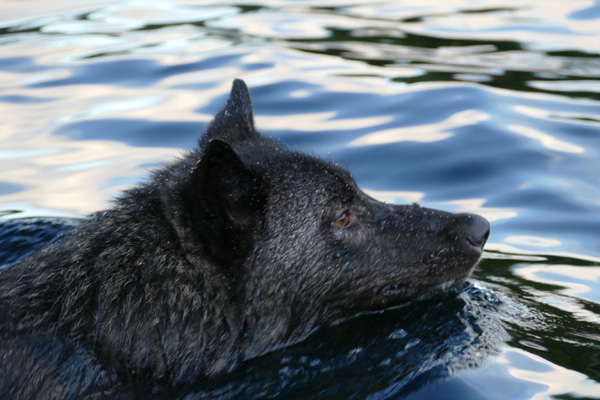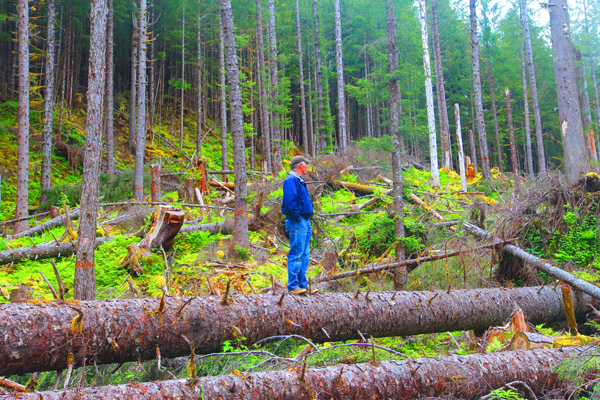
By Matt Miller, senior science writer
Wolves. Logging. Trapping. Endangered species listing.
The essential ingredients for conservation gridlock? A path to polarization? Nifty click-bait to bring every angry internet commenter to this blog?
None of the above.
In fact, this is not the narrative you expect – it’s one in which conservation science has the potential to reduce conflict around these oft-heated topics, at the same time benefiting wildlife, people and the local economy.
On Prince of Wales Island in Southeast Alaska, Conservancy scientists are researching whether the harvest of young growth forests could actually benefit wolves – potentially helping to keep them off the Endangered Species list.
Before seeing how forest harvest can help wolves, you have to understand a bit about the unique situation with wolf conservation and management on Prince of Wales Island.
Let’s acknowledge this: Because many people have definitive opinions about wolves, it can be difficult to think about these animals clearly.
It can also be literally difficult to see them clearly.
On Prince of Wales Island, this is especially true: here, the wolves are even harder to study than in other parts of their range. They live in unimaginably dense forests and rugged terrain. It’s often raining. Hard.
Several environmental groups have petitioned to have the Alexander Archipelago wolf – as the wolf on Prince of Wales is known – listed under the Endangered Species Act.
Some also suggest that the Prince of Wales population of wolves is a subspecies, or a distinct population segment, as they believe it is geographically isolated. The Alexander Archipelago wolf ranges throughout most of the islands and the coastal area of Southeast Alaska.
Many, including some scientists, question whether the Prince of Wales population of wolves are truly a subspecies. They note the documented ability of wolves to swim more than eight miles, allowing genetic exchange with other populations.
A lot of local residents believe the concerns about the wolf’s population are overstated.
But without data, the real picture remains…murky.
“The wolf is an important species in the ecosystem here,” says Colin Shanley, an ecologist for The Nature Conservancy in Alaska. “Obviously, we don’t want it to disappear. We do want to have the best information, so that our conservation and forest restoration can be most effective.”
“The problem is,” he continues, “Catching a wolf on Prince of Wales is like catching a mermaid.”

Gretchen Roffler was used to capturing wolves on the tundra and fitting them with GPS collars. Then a biologist with the U.S. Geological Survey, she would then use fix-winged aircraft to track the wolves back to their packs, providing accurate population counts.
She recently moved to Southeast Alaska, taking over wolf research on Prince of Wales Island for Dave Person with the Alaska Department of Fish and Game. “It was a completely different story here,” says Roffler. “So often the wolves are in deep forest. It can be tough to find them.”
Right now, only one wolf is collared, providing at best an incomplete picture.
Biologists had also developed a method to collect hair samples from live wolves. Small pieces of plywood with barbed wire attached are fixed to the ground in various locations where wolves are expected to pass.
A stinky lure/paste is applied to the board which induces the wolf to roll – much as your dog might roll in something stinky.
When the wolf rolls, hair catches on the barbed wire.
Roffler expanded the program to include more hair traps.
When the hair is collected, DNA is extracted from the follicle, providing much more information on the number of wolves. Additionally, trail cameras are used in conjunction with the trap.
But still, Roffler found that she could use more assistance, especially from the local community. “People here are scared about the listing and what that would mean for their livelihoods,” she says.
The people who know wolves best might seem, to an outsider, to be unlikely allies in wolf conservation: wolf trappers.
They have a wealth of information to share but they were understandably skeptical. The biologists needed someone who understood conservation and also had the trust of the local community. Enter the Conservancy’s Michael Kampnich.
I first met Kampnich two years ago on Prince of Wales, when we met sawmill operators looking for new markets for sustainable wood products. What struck me first was Kampnich’s endless curiosity and extensive knowledge of wildlife, history, economics and more.
But he also had a clear empathy for people affected by conservation. A commercial fisherman and former logger, Kampnich knows the concerns of the local community.
“Most people who know me know I’m not for locking anything up,” he says. “I’m interested in really finding balance that ensures opportunities to utilize any resource, while ensuring that resource remains healthy and viable.”
He has been friends with some of the island’s best wolf trappers for many years. “By and large the trappers are actually supportive of research and efforts that ensure wolf populations are maintained at a viable level,” he says. “The key is they have to be confident that the researchers are truly focusing on science and not a preconceived agenda.”
Kampnich’s own knowledge of the island has been lent to the research effort. He has helped place the hair snares and camera traps, often in remote areas.
He has captured some excellent footage of wolves via camera trap, including the videos in this blog.
Solid evidence exists that the wolf population is declining. In part, that may be due to overharvest. The Alaska Department of Fish and Game has reduced harvest quotas.
Overharvest may be occurring because logging roads provide easier access for hunters and trappers to get into wolf habitat.
So it may seem counterintuitive that one way to boost wolf numbers may be through logging.
Much of Prince of Wales was extensively logged twenty to thirty years ago. The old-growth forest that existed there consisted of a mosaic of habitat.
After logging, the habitat was largely uniform. Today, the trees are a uniform height and block out new growth. This makes walking through the forest nearly impossible for a human.
And it’s equally unsuitable for a deer.
For an in-depth explanation of the effects this young growth forest has, see my previous blog.
While the wolves of Prince of Wales are well known for their habit of gorging on spawning salmon in late summer and fall, deer remain a highly important prey item. There are no elk, caribou or moose on Prince of Wales.
The first part of the research is conducting habitat modeling that shows how much deer habitat is lost due to the uniform forest structure.
This helps direct where restoration could have the most positive outcomes.
The Conservancy has also been actively researching restoration of these young growth forests, which means cutting trees to create forest openings. Part of this is creating a market for young growth wood products, which would help the local economy.
This cutting could also be done in a way to help wolves. “We are researching different treatments and how they affect deer,” says the Conservancy’s Colin Shanley. “We know that one of the things wolves need is a big prey base. We also believe an abundant prey base means less travel for wolves, making them less exposed to hunting and trapping.”
Creating deer habitat has some nuances. One of them is that, while part of the goal may be to increase food for wolves, the habitat can’t leave the deer too vulnerable to wolves.
“A big part of the research and restoration here is aimed at reestablishing a balance,” says Shanley. “We don’t want deer or wolf too have too much of an advantage. We want a variety of treatments so that the forest is healthy, and predator-prey relationships are healthy.”
In one of the ironies of this story, an endangered species listing could actually make it more difficult to conduct forest restoration.
“Undertaking any management activity becomes so much harder with a listing,” says Shanley. “It also would undoubtedly affect the local community. We believe habitat restoration can work. If we can bring a bunch of deer back with improved habitat that will benefit wolves.”
The Conservancy’s goal here is to accomplish all this with the harvest of young forests: A healthy forest. Habitat for deer, wolves and other wildlife. Wood products that can be sold. A vibrant local economy.
Accomplishing that rests on solid research and solid data. Wolves, endangered species, logging and trapping are all potentially explosive topics, but conservation science shows that it doesn’t have to be that way.
That may sound hopelessly naïve, but that is how the story is playing out on Prince of Wales Island.
“We have goals for forest conservation in southeast Alaska, and that includes conserving key indicators of forest health like wolves,” says Shanley. “We can use the information we get from diverse sources, from habitat modeling to hair traps, to inform our decisions. We want those decisions to shape the best possible future, for wolves, for deer, for forests and for the community.”
Opinions expressed on Cool Green Science and in any corresponding comments are the personal opinions of the original authors and do not necessarily reflect the views of The Nature Conservancy.
The Nature Conservancy is the leading conservation organization working around the world to protect ecologically important lands and waters for nature and people.



